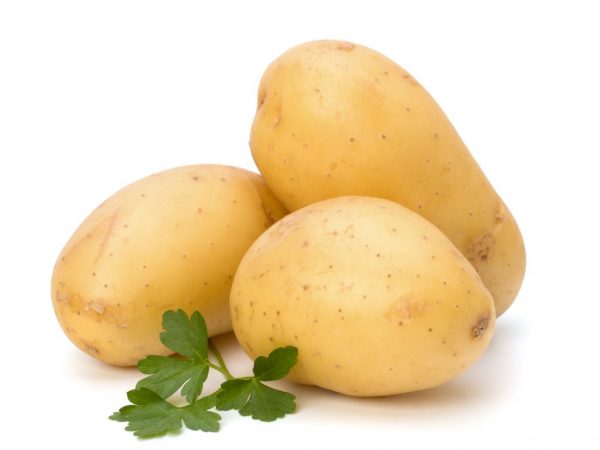Description of Lady Claire potatoes
Lady Claire's potatoes are in demand due to their presentation and ability to be stored for a long time

Description of Lady Claire potatoes
Characteristic
Lady Claire's seed potatoes were first produced in Holland. This plant belongs to the early maturing species.
If you plant Lady Claire in the south, you can harvest several times in one season. The variety is great both for home cultivation and for breeding on large farms.
Description of the bush
According to the description, the Lady Claire potato bush belongs to the leafy early maturing type, which has an average height of about 50 cm. The plant is semi-erect and completely covered with leaves. The stems are fairly firm and do not sink to the ground until fully ripe. The leaves can be of medium or large size, themselves slightly elongated. The leaves are bright emerald in color and are of the open type.
The serration of the leaves is small. The corolla is white and small in size. A large number of tubers grow on one bush near Lady Claire's potatoes. The tuber itself is slightly elongated, has slightly rounded edges. In the process of flowering, small flowers appear on the bush, which fall off, after which berries appear on them.
Description of the fetus
The Lady Claire potato variety has medium-sized fruits. The shape of the potatoes is round. The rind has a smooth or slightly rough texture. Its color can be beige-yellow, slightly darker or lighter. The fruit has medium and small eyes. Lady Claire seed potatoes have a fairly light beige-yellow flesh, the starch content of which is approximately 16-17%. The weight of one fruit ranges from 83-106 g.
Lady Claire's taste is excellent. Due to this starch content in fruits, potatoes are often used to create starch and potato flour.
Dignity
The Lady Claire variety attracts with a huge number of advantages, which include:
- high productivity;
- resistance to serious diseases;
- non-susceptibility to attack by pests;
- non-degeneration of tubers;
- versatility of use;
- undemanding care;
- beautiful appearance;
- pleasant taste;
- possibility of transportation over long distances;
- a large amount of amino acids, carotene and vitamin C in the composition.
Minuses
Disadvantages, according to the characteristics, are few. The only thing that you should definitely pay attention to is the quality of the soil where the seed potatoes will be planted, and its further watering.
If the fruit and plant have very little moisture, it will become shallow over time, but this can only be expected if the plant is very small.
Growing rules

Proper care will ensure a good potato crop
Before planting in the ground, potatoes are etched with a solution of potassium permanganate or special compounds.
In the process of planting, the tubers are not cut, as this leads to their rapid deterioration. For the germination of root crops, it is better to grow them outdoors in boxes filled with sand. For the safety of plants, the land is cultivated with the help of medicinal preparations and insecticides.
Seed preparation
The species may not degenerate for several years, so it is used as planting material for the next year. Despite this, farmers recommend renewing seeds every 5 years and not growing old tubers.
The seeds are germinated about 14 days before planting in the ground. To do this, the seeds are placed in small boxes, which are then removed to a warm but dark place. Some farmers like to cut the planting material into several parts, but it is contraindicated to carry out such actions with this view: the potatoes do not germinate.
It is necessary to ensure that the vegetables contain live eyes in the absence of sprouts. In this case, the peel should be smooth, not wrinkled.
Planting in soil
Potatoes of this variety are planted in the soil when it warms up to at least 12 ° C.
Landing methods include traditional smooth and ridge landing. The option of planting seed in the so-called trenches is not excluded. This process must be carried out in rows, the distance between which should be approximately 25-30 cm.The depth at which the seed should be placed should be 70-80 cm.
Plant care
Plant care, as described, includes the following steps:
- weeding;
- loosening;
- top dressing;
- watering;
- hilling;
- preventive spraying.
The soil is loosened for the first time during the planting process. It is important to remove all weeds and remnants of past plants. The bushes must be spud so that there is room for further growth due to the formation of high beds.
Watering should not be overused. It is advisable to water the plant during severe drought. To preserve moisture in the soil, mulching is performed.
Fertilization is carried out when the process of forming a bush begins to occur. Phosphorus and potassium are used as fertilizers. It is advisable to refuse nitrogen-containing agents, as they harm the tubers.
Diseases and pests
The uniqueness of the Lady Claire potato is that it is practically not affected by diseases of the nightshade family. Rarely, there is a cyst-forming nematode, rhizoctonia, scab, black leg and tuber rot. If the plant grows in unfavorable conditions for itself, it may be affected by late blight.
Due to the dense peel, the fruits are not damaged by wireworm, Colorado potato beetle and bear. Those wishing to protect the plant from the adverse effects of pests can be sprayed with insecticides, but only until the flowering process has begun.


